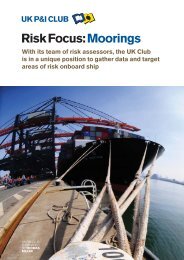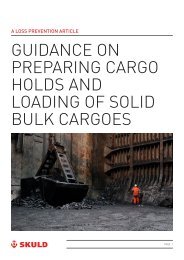You also want an ePaper? Increase the reach of your titles
YUMPU automatically turns print PDFs into web optimized ePapers that Google loves.
<strong>ECSA</strong><br />
<strong>The</strong> <strong>Tramp</strong> <strong>Shipping</strong> <strong><strong>Mar</strong>ket</strong><br />
8. Definition of the <strong>Shipping</strong> <strong><strong>Mar</strong>ket</strong>s<br />
8.1 <strong>The</strong> four markets where cargo and ships are traded<br />
In shipping there are four markets trading in different commodities. <strong>The</strong> freight market trades in<br />
sea transport of commodities; the charter market deals in ships for hire; the sale and purchase<br />
market trades second-hand ships; and the newbuilding market trades new ships. Beyond this there<br />
is no formal structure.<br />
Because the same companies are trading in all four shipping markets, their activities are closely<br />
correlated. When rates rise or fall in the freight market the effect is transmitted into the sale and<br />
purchase market and from there into the newbuilding 14 market. <strong>The</strong> markets are also linked by<br />
cash. <strong>The</strong> relationship is shown graphically in Figure 8. Cash flows back and forth between the<br />
industry's bank account (represented by the circle) and the four shipping markets (represented by<br />
the squares). <strong>The</strong> cashflow into the shipping companies' bank account is shown by the light<br />
shaded bars, while the black bars show outflows. <strong>The</strong> hatched bars indicate cash which changes<br />
hands from one shipowner to another, but does not change the cash balance of the industry as a<br />
whole.<br />
8.2 <strong>The</strong> role of market cycles in the competitive process<br />
<strong>The</strong> cash flowing between the four markets drives the shipping investment process. At the<br />
beginning of the cycle freight rates rise and cash starts to flow in, allowing shipowners to pay<br />
higher prices for second-hand ships. As prices are bid up investors turn to the newbuilding market<br />
which now looks better value. But as the ships arrive on the market two years later the whole<br />
process goes into reverse. Falling freight rates squeeze the cash inflow just as investors start<br />
paying for their newbuildings. Financially weak owners who cannot meet their day-to-day<br />
obligations are forced to sell ships on the second-hand market. <strong>The</strong>se sales are often preceded by<br />
a, usually prolonged, period of declining rates. As ships are scrapped the supply falls, freight rates<br />
are bid up and the whole process starts again. Table 4 Type of Charter Arrangement<br />
<strong>The</strong> cycles create a continuous movement of<br />
companies in and out of the market. <strong><strong>Mar</strong>ket</strong><br />
cycles squeeze out the inefficient companies,<br />
and allow new and efficient companies to enter<br />
the market and gain market share. This is how<br />
the shipping industry directs investment and<br />
promotes efficiency.<br />
Changes in supply and demand can impact the<br />
price paid for freight very quickly.<br />
9. “Voyage Charter” Contract<br />
In bulk shipping, a voyage charter allows the<br />
shipper to buy transport from the shipowner at a<br />
negotiated price per ton of cargo transported.<br />
<strong>The</strong> market contract suits shippers who want to<br />
leave the management of the transport to the<br />
shipowner, while the time charter is for<br />
experienced ship operators who prefer to<br />
manage the transport themselves.<br />
Type of Charter Arrangement<br />
Bareboat Timecharter Voyage Charter<br />
Master appointed &<br />
directed by:-<br />
Master appointed by<br />
owner, directed by<br />
Master appointed and<br />
directed by:-<br />
Charterer Charterer Owner<br />
Revenue depends on:- Revenue depends on:- Revenue depends on:-<br />
Hire rate & duration Hire rate & duration Quantity of cargo & rate<br />
Costs paid by owner:- Costs paid by owner :- Costs paid by owner:-<br />
Capital Capital Capital<br />
Brokerage Brokerage Brokerage<br />
Wages<br />
Provisions<br />
Maintenance<br />
Repairs<br />
Stores & supplies<br />
Lube oil<br />
Water<br />
Insurance<br />
Overheads<br />
14 <strong>The</strong>re is strong competition between shipbuilding nations and yards within each nation.<br />
Wages<br />
Provisions<br />
Maintenance<br />
Repairs<br />
Stores & supplies<br />
Lube oil<br />
Water<br />
Insurance<br />
Overheads<br />
Port charges<br />
Stevadoring charges<br />
Cleaning holds<br />
Cargo claims<br />
Light dues<br />
Canal dues<br />
Bunker fuel<br />
Contract of Afreightment (COA): cost profile same as voyage charter<br />
Source: Clarkson<br />
Research Services<br />
Clarkson Research Services Limited 27 <strong>Mar</strong>ch <strong>2015</strong>




